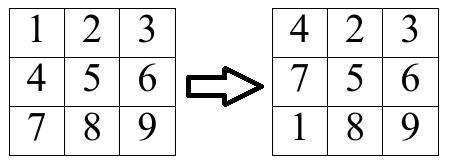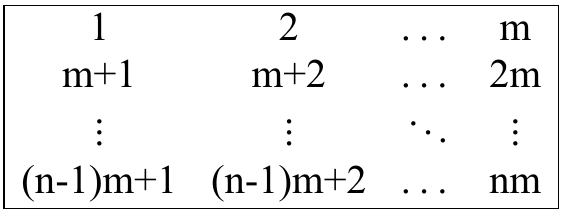Preparando MOJI
You are given a rectangular matrix of size $$$n \times m$$$ consisting of integers from $$$1$$$ to $$$2 \cdot 10^5$$$.
In one move, you can:
A cyclic shift is an operation such that you choose some $$$j$$$ ($$$1 \le j \le m$$$) and set $$$a_{1, j} := a_{2, j}, a_{2, j} := a_{3, j}, \dots, a_{n, j} := a_{1, j}$$$ simultaneously.
 Example of cyclic shift of the first column
Example of cyclic shift of the first column You want to perform the minimum number of moves to make this matrix look like this:

In other words, the goal is to obtain the matrix, where $$$a_{1, 1} = 1, a_{1, 2} = 2, \dots, a_{1, m} = m, a_{2, 1} = m + 1, a_{2, 2} = m + 2, \dots, a_{n, m} = n \cdot m$$$ (i.e. $$$a_{i, j} = (i - 1) \cdot m + j$$$) with the minimum number of moves performed.
The first line of the input contains two integers $$$n$$$ and $$$m$$$ ($$$1 \le n, m \le 2 \cdot 10^5, n \cdot m \le 2 \cdot 10^5$$$) — the size of the matrix.
The next $$$n$$$ lines contain $$$m$$$ integers each. The number at the line $$$i$$$ and position $$$j$$$ is $$$a_{i, j}$$$ ($$$1 \le a_{i, j} \le 2 \cdot 10^5$$$).
Print one integer — the minimum number of moves required to obtain the matrix, where $$$a_{1, 1} = 1, a_{1, 2} = 2, \dots, a_{1, m} = m, a_{2, 1} = m + 1, a_{2, 2} = m + 2, \dots, a_{n, m} = n \cdot m$$$ ($$$a_{i, j} = (i - 1)m + j$$$).
3 3 3 2 1 1 2 3 4 5 6
6
4 3 1 2 3 4 5 6 7 8 9 10 11 12
0
3 4 1 6 3 4 5 10 7 8 9 2 11 12
2
In the first example, you can set $$$a_{1, 1} := 7, a_{1, 2} := 8$$$ and $$$a_{1, 3} := 9$$$ then shift the first, the second and the third columns cyclically, so the answer is $$$6$$$. It can be shown that you cannot achieve a better answer.
In the second example, the matrix is already good so the answer is $$$0$$$.
In the third example, it is enough to shift the second column cyclically twice to obtain a good matrix, so the answer is $$$2$$$.